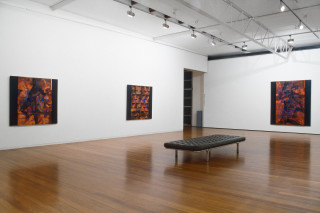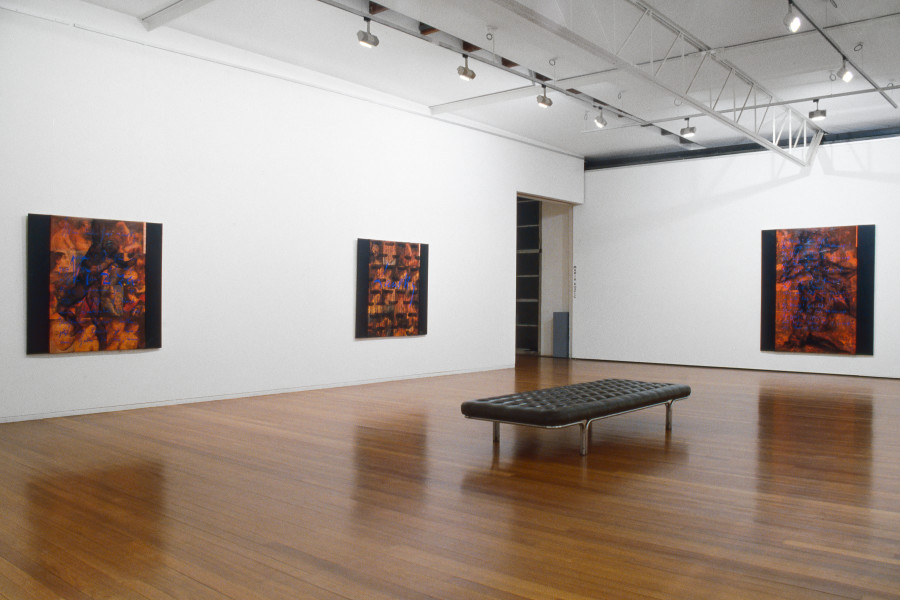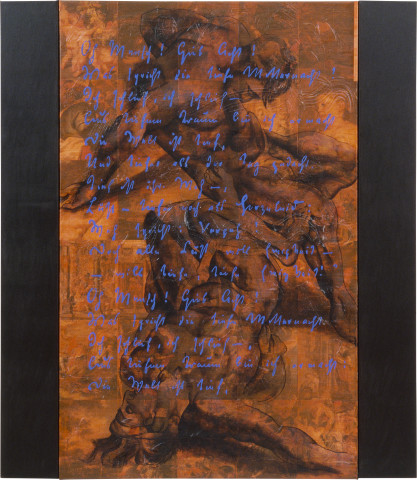Mark Titmarsh's third solo exhibition at Roslyn Oxley9 Gallery.
Exhibition Dates: 20 November – 7 December 1991
What I do is not painting. What I do contains painting as an element within a broader construction of objects, images and visual aphorisms. I would like to call it the work of an Artist-Philosopher and what is produced, Conceptual Painting.
Conceptual Painting may be said to contain a whole series of displaced painterly paradigms: portraiture, landscape, still life, anatomical studies, brushwork, impasto, colour theory and signature together with non-painterly elements: objects of mass industrial production, fragments of global culture and the perceptual environment occupied when viewing art, space, history and subjectivity.
Conceptual Painting insists on the destruction of the stereotype 'stupid as a painter' and the relegation of the type of painter who relies on spleen and stomach in favour of the artist who appeals to the mind and integrated senses.
To some extent artists have always been philosophers in that their work has directly or indirectly proposed a view of the world and the individual. The title 'Aritist-Philosopher' makes this an affirmative role with a call to action - to make sense of the complex time we live in. To cope the Artist-Philosopher must be skilled in several disciplines beyond the arts to be able to confront the depth of information and eventfulness that surrounds us.
Multitudes of informational fragments in the form of news, history, fashion and entertainment enter and exit this world through various forms of media and in various degrees of significance and intensity. Layering has come to be the preferred method of delivery and storage of such information. These new depths that surround us might also be described as new kind of space, Data Space.
Data Space has depth like classical space except that it is not ordered around a single coherent viewpoint. It has many possible viewpoints and independent unhinged planes that establish something more like a hyperspace that cannot be bound by the conventions of three dimensions and one point perspective.
Data Space is hyper-dimensional and fundamentally intertextual since it facilitates all type of traffic as it emanates from the innumerable centres of culture. This new kind of space demands a reconfiguration of the classical models of vision and observer just as radical as the one that took place during Renaissance when perspective was established as the dominant perceptual mode.
In Data Space visual representation is no longer the primary goal since most of the traditional functions of the eye have been replaced by practices in which images no longer have any reference to the position of an individual observer in a real or optically perceived world. When vision becomes severed from the human observer then perception of the world becomes something of a matter for the integrated senses not just the organ of sight, the eye. Consequently the eye and the regime of images is supplanted by a proliferation of perceptual environments that awaits a proper name and a new kinds of observer.
Mark Titmarsh
November 1991
 Group Show, Christmas show
Group Show, Christmas show
Roslyn Oxley9 Gallery, 1991
 Mark Titmarsh Glaciers
Mark Titmarsh Glaciers
Roslyn Oxley9 Gallery, 1991
 Mark Titmarsh Garden of forking paths
Mark Titmarsh Garden of forking paths
Roslyn Oxley9 Gallery, 1990
 Mark Titmarsh Fresh
Mark Titmarsh Fresh
Roslyn Oxley9 Gallery, 1989
 Group Show, The Cocktail Party (All Gallery Artists)
Group Show, The Cocktail Party (All Gallery Artists)
Roslyn Oxley9 Gallery, 1988




















